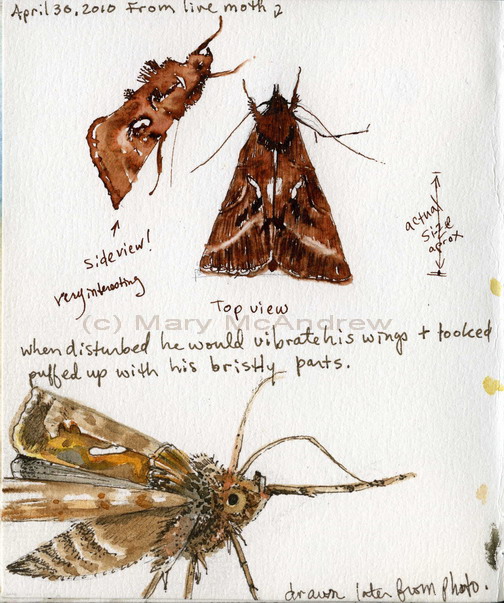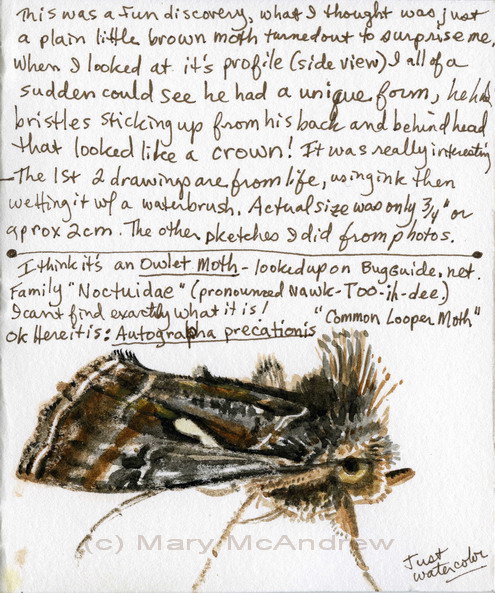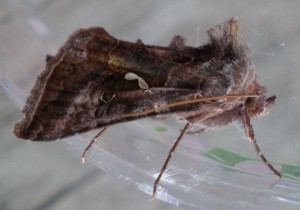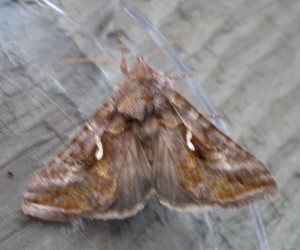Well at first I was going to call this post “Little Brown Moth” as I couldn’t guess what kind it was. Have a look at my sketches below and then read about how I figured out what it was.
The last time I found a moth it was a fugitive hiding behind my kitchen door curtain, this one was very similar. He was inside my kitchen sliding door frame…just another ordinary little brown moth. I dismissed it as such and thought, well later I’ll look at him and maybe do a sketch. All I could find to hold him while I studied him (without hurting him) was an empty camera lens case; it’s extremely clear, round, flat and about 3″ across. I made sure not to close it so he could have air and tried to work quickly, I am mindful of his life in my hands and don’t want to stress him too much.Trying not to touch his wings I gently cupped my hand over him and could feel him fluttering inside my hand.
He did get away I’ll admit, then it was actually easy to hold the lid over him then put the bottom up to catch him from off the exhaust hood over my stove…with me perched on a chair!
The first two sketches are done from life using a quill pen and brown ink. The ink will run when wet so I used a waterbrush to gently touch it and ‘make’ it run; it turns a beautiful reddish brown when you wet it. (Pelican ink) I also noted the actual size, you can see it’s quite small so a magnifying glass was handy to help me see him.
The drawing on the bottom of the page (above) is done while looking at a photo I took of him. I put a very light sketch in pencil then used my permanent brown ink pen, to which I added some watercolors. This study is only 2″ tall, pretty small in my tiny sketch book.
You can see from my notes, what was so interesting about this little brown moth is his profile! When I looked at him from the side I was surprised to find the bristles sticking up like a crown or furry coat. He also has a big ‘nose’ looking thing, I think that’s actually his tongue or mouth parts?
Here are two photos I got of him as I released him outside; it was going dark so the lighting isn’t great. I think the best shots I’ve gotten of captured insects are when I am about to release them, outside on my screen porch in natural light. The photo below is blurry, SORRY! but the light was fading, I just wanted to show you his wing pattern.
Now a few notes about how I identified him. After studying his form and the unusual profile this helped me, I took note of the whitish marks on his wings and the color of the ‘underwing’. I went to my “Nature Links” page and clicked on “Bug Guide.net”; this site is very helpful but sometimes can be difficult if you’re a beginner like me. I started with “Moths”, click on that, then they showed a silhouette box and that was most helpful. I clicked on the one that looked just like my bug, and from looking it up in my “Field Guide to Insects and Spiders of North America” I at least figured out that it’s some kind of Owlet Moth. Cool, well, now what? My field guide gave me no more help, but on the Bug Guide website I saw another website called “Moth Photographers Group”, (now a link on my Nature Links page!) and when I went to a page it recommended, I was able to really see so many moths and almost certainly identify mine. Then I copied the name and went back to “Bug Guide” and pasted it in the search box, oh wow!, lots of pictures came up now of MY MOTH! Yes, that’s it, an Autographa precationis!
A tip from me, on Bug Guide, if you find a page with pictures you want to look at, use your back button to return from looking at a photo or else it will bring up a whole new set of pictures, not sure why. Another tip, when you visit the Moth Photographers Group, to see pictures go to the “Plate Series” page for links to pictures, BUT I highly recommend starting with Bug Guide or your Field Guide to get an idea of the scientific name, it’s the only way to search on this site.
I hope you enjoyed discovering more about this not so plain little brown moth with me! What it teaches us, if you look at something much closer, with curiosity, you can discover new things you never knew were right under your nose!




Very lively sketches Mary! Nicely done.
Thanks Mona, this was hard to do because it was such a little moth, with drab colors. What an interesting little moth though!